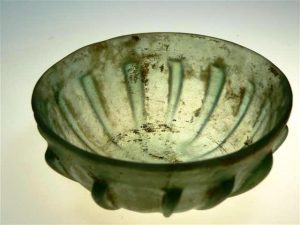Antique ribbed bowl - German/German

Roman ribbed bowls were considered the successful model of ancient glass production because of their simple and quick production. It took Roman glassmakers no more than two minutes to make the bowls, which were used as drinking vessels, virtually "ready for dispatch". The secret of success lay in the use of a turntable on which a thick hot glass cake was lowered over a reusable core mould. A tool was used to press in the ribs and thus expand the shell at the same time. Of course, the shell could still be tweaked a little. If the client wanted curved ribs, for example, the lathe was turned, while for straight ribs it stood still. The rim could also be ground and polished. Ribbed bowls were in fashion from the first pre-Christian to the first post-Christian century.
Besides the wheel, two other inventions were responsible for the enormous upswing and high level of Roman glass art: firstly, the invention of the glassmaker's pipe in the 1st century BC on the Syrian-Palestinian coast. With this new technique of glass blowing, the hot glass mass was blown into moulds. Now simple hollow glass, such as bottles, flacons and jugs, as well as flat glass could be produced in series. Glass manufactories sprang up like an explosion all the way to the Roman provinces north of the Alps. This meant that nothing stood in the way of the development from luxury glass to utility glass.
The second revolutionary development was the discovery of the artificial decolourisation of glass by adding manganese dioxide. Now it was possible to produce a very bright translucent and transparent glass, which was ideal for the production of Roman window panes and the experiments of the alchemists.
Antique Ribbed Bowl - English

As a result of their simple and fast production process Roman ribbed bowls that were used for drinking from, were considered an antique glass production success. Roman glassmakers needed no longer than two minutes to produce a ready-to-despatch model. The secret of their success lay in the use of a type of potter's wheel upon which a thick, hot piece of molten glass was lowered onto a reusable mould. A tool was used to press in the ribs and the bowl was expanded at the same time. Afterwards of course, the bowl could be filed down a bit. If the contractor wanted curved ribs for example, the potter's wheel was turned, but for straight ones it stood still. The edge of the bowl could also be smoothed and polished. Ribbed bowls were in fashion from the 1st century BC to the 1st century AD.
Alongside the potter's wheel, two other inventions generated an enormous boom in Roman glass art and created its high status: one was the invention of the glassmaker's glassblowing pipe in the 1st century BC on the Syrian-Palestinian coast. This new glassblowing technique meant the molten glass could be blown into shape and simple "hollow glass forms," like bottles, vials and jugs, as well as flat glass, could be serially produced. Glass manufacturers suddenly sprang up all over the Roman provinces north of the Alps and nothing could hinder the transformation from luxury glass into everyday glass.
The second revolutionary development was the discovery of artificially colouring glass, using manganite. This made the production of a very pale and translucent glass possible that was ideal for Roman windowpanes and alchemists' experiments.